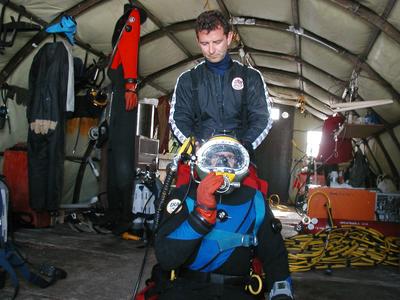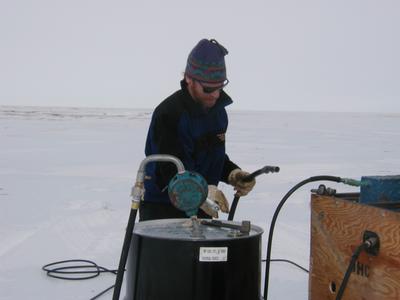
|
|
9 November, 2001
After breakfast this morning, we went to the dive hut to observe Phil
Forte's first surface air supply dive. Phil Forte is an Alvin pilot with
the Woods Hole Oceanographic Institute. He takes scientists down in the
ocean by means of a three-person submersible. The Alvin is the submersible
that first dove on the Titanic. Rob Robbins, the science dive coordinator
from McMurdo, and Dr. Pollock were monitoring the process for this special
certification. A surface air supply dive requires more skill than scuba
diving. It requires the diver to wear a Kirby Morgan band mask, a
full-faced mask, which is hooked to the air supply at the surface. The
mask allows the diver to talk while under water. The courage begins with
trust for the person on the surface who controls the air piped into the
mask. I was impressed with the ease and composure Phil Forte had when he
cut off the surface supply of air and switched to his emergency backup
tank. He is testing all of the valves needed to regulate his air supply.
(If too much air comes in at once, a valve can be adjusted to regulate the
amount coming into the mask.) When Phil Forte surfaced, then Dr. Pollock
and Dr. Bowser suited up to dive. Tim Brox, the Eagle Scout experiencing
Antarctica, helped as tender. He clipped blinking flashlights at different
intervals, as well as an extra air supply along the guide rope. A basket
on the end of the rope held their collecting bottles for sediment cores.
Everyone was ready for something warm to eat after leaving the dive hut.
One frequently asked question from students has been in regard to what I am
eating in the field. For lunch, we had New England Clam Chowder from a can.
We also had "canned" bread. It was interesting. For dinner, Dr. Pollock,
made Spinach Fettuccine Alfredo with Canadian bacon, frozen vegetables,
and brownies. It was really good. We all take turns cooking.
In the middle of the afternoon, a helicopter brought in a large melter to
make a hole through the sea ice. This opening will be used to take
hydrology (water) measurements, such as water temperature, pH, and
alkalinity, of the seawater. The water chemistry, especially during
seasonal changes, can affect the forams and other organisms living within
the water site.
I drove a Ski-Doo out to meet Dr. Bowser, Rob, and Tim at the drill site.
Dr. Korsun started the Ski-Doo for me, gave me instructions on how to
carefully drive it through the rough ice in the transition zone (where the
land meets the sea), and pointed me in the right direction. He then
radioed ahead to let them know that I was on my way. I arrived at the
hole-melting site to see a small hole being drilled through the ice. A
motor placed on top forced the drill down through the ice. Drill
attachments had to be added to get through 12 feet of sea ice. Dr. Bowser
jokingly measured the attachments in "Bowser lengths"- the length of the
drill was two Dr. Bowsers. Tim rode on the sled as Dr. Bowser drove the
ATV back to camp to retrieve the generator. "Frustrations of Antarctica"
arose again as we realized that the plug to the drill would not fit into
the generator. Another generator would need to be flown out by helicopter
before the hole could be melted.
It is not uncommon for bedtime to run between 1 a.m. to 3:00 a.m. The light
outside is deceiving. It is always a surprise to look at my watch to see
that time has flown by, as I force myself to bed with unfinished work
still to do.

Phil Forte, one of the divers on this research team, is making a surface air supply dive. Air will be pumped through a hose from the surface. He will be able to communicate with the people at the surface while he is under water.

I took a Ski-Doo to the nearby drill site. Spike, the penguin sent by my students, reminds me of my students. I can't wait for them to learn about the science research going on at Explorers Cove! It takes a lot of preparation to get everything in place. The hole in the ice will be used for a hydrology (water) study.

Dr. Bowser, Rob, and Tim drilling into the ice in preparation for melting a hole to collect hydrology (water) measurements. Attachments were added to each drill section until the drill broke through the ice. The ice was about 12 feet thick at this site. The motor at the top of the drill helped push the drill sections through the ice.

The fuel, generator, and supplies were brought to the melting site by ATV and Ski-Doos. Little things like these are constant reminders that everything takes a little more effort in Antarctica. The time is filled with the simple things we take for granted in our daily lives at home. Instead of driving up to a fuel pump, the fuel pump must be attached to an ATV and carried over the sea ice.
Contact the TEA in the field at
.
If you cannot connect through your browser, copy the
TEA's e-mail address in the "To:" line of
your favorite e-mail package.
|
